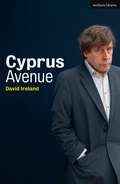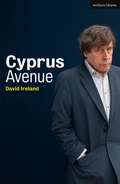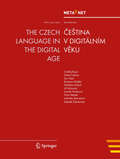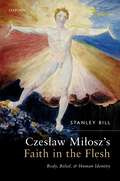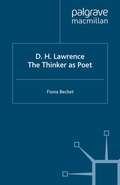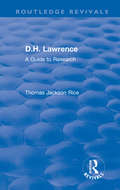- Table View
- List View
Cynewulf: Basic Readings (Basic Readings In Anglo-saxon England Ser.)
by Robert E. BjorkTwo original essays and 16 published since 1950 offer a comprehensive view of Cynewulf, his language, and his poetry. The collection contains important new statements on dates, provenance, and canon by R.D. Fulk and Patrick W. Conner, four influential essays that thoroughly explore Cynewulf's runic signature and poetic style, and major contributions to our understanding of the four signed poems of Cynewulf, Fates of the Apostles, Christ II, Juliana, and Elene. Three essays are devoted to each of these poems, and the essays themselves exemplify a broad range of approaches to this highly elusive Anglo-Saxon poet. The volume complements existing book-length treatments of the subject and will be welcome to scholars and students who need the foundations of Cynewulf scholarship at their fingertips.
Cynewulf: Basic Readings
by Robert E. BjorkTwo original essays and 16 published since 1950 offer a comprehensive view of Cynewulf, his language, and his poetry. The collection contains important new statements on dates, provenance, and canon by R.D. Fulk and Patrick W. Conner, four influential essays that thoroughly explore Cynewulf's runic signature and poetic style, and major contributions to our understanding of the four signed poems of Cynewulf, Fates of the Apostles, Christ II, Juliana, and Elene. Three essays are devoted to each of these poems, and the essays themselves exemplify a broad range of approaches to this highly elusive Anglo-Saxon poet. The volume complements existing book-length treatments of the subject and will be welcome to scholars and students who need the foundations of Cynewulf scholarship at their fingertips.
The Cynewulf Reader (Basic Readings in Anglo-Saxon England)
by Robert E. BjorkThe Cynewulf Reader is a collection of classic and original essays presenting a comprehensive view of the elusive Anglo-Saxon poet Cynewulf, his language, and his work.
The Cynewulf Reader (Basic Readings in Anglo-Saxon England #4)
by Robert E. BjorkThe Cynewulf Reader is a collection of classic and original essays presenting a comprehensive view of the elusive Anglo-Saxon poet Cynewulf, his language, and his work.
The Cynic Enlightenment: Diogenes in the Salon (Parallax: Re-visions of Culture and Society)
by Louisa SheaThis original study reveals the importance of ancient Cynicism in defining the Enlightenment and its legacy. Louisa Shea explores modernity's debt to Cynicism by examining the works of thinkers who turned to the ancient Cynics as a model for reinventing philosophy and dared to imagine an alliance between a socially engaged Enlightenment and the least respectable of early Greek philosophies. While Cynicism has always resided on the fringes of philosophy, Shea argues, it remained a vital touchstone for writers committed to social change and helped define the emerging figure of the public intellectual in the 18th century.Shea's study brings to light the rich legacy of ancient Cynicism in modern intellectual, philosophical, and literary life, both in the 18th-century works of Diderot, Rousseau, Wieland, and Sade, and in recent writings by Michel Foucault and Peter Sloterdijk. Featuring an important new perspective on both Enlightenment thought and its current scholarly reception, The Cynic Enlightenment will interest students and scholars of the Enlightenment and its intellectual legacy, 18th-century studies, literature, and philosophy.
Cyprus Avenue (Modern Plays)
by David IrelandGerry Adams has disguised himself as a newborn baby and successfully infiltrated my family home.Eric Miller is a Belfast Loyalist. He believes his five-week old granddaughter is Gerry Adams.His family keep telling him to stop living in the past and fighting old battles that nobody cares about anymore, but his cultural heritage is under siege. He must act.David Ireland's black comedy takes one man's identity crisis to the limits as he uncovers the modern day complexity of Ulster Loyalism.Cyprus Avenue was first performed at the Abbey Theatre, Dublin in 2016, before transferring to the Royal Court Theatre, The MAC in Belfast and The Public Theater in New York.
Cyprus Avenue (Modern Plays)
by David IrelandGerry Adams has disguised himself as a newborn baby and successfully infiltrated my family home.Eric Miller is a Belfast Loyalist. He believes his five-week old granddaughter is Gerry Adams.His family keep telling him to stop living in the past and fighting old battles that nobody cares about anymore, but his cultural heritage is under siege. He must act.David Ireland's black comedy takes one man's identity crisis to the limits as he uncovers the modern day complexity of Ulster Loyalism.Cyprus Avenue was first performed at the Abbey Theatre, Dublin in 2016, before transferring to the Royal Court Theatre, The MAC in Belfast and The Public Theater in New York.
Cyrano (Modern Plays)
by Edmond Rostand Deborah McAndrewHis uniform is picturesque; a hat with triple plumeDoublet, cape, and sword - worn like a peacock's tail.From the eyebrows up, he's all feathersFrom the neck down, it's buckle and swash -But squeezed between is a nose – a nose...A modest poet such as I must fail entirelyTo describe this gross, immodest, monstrous nose.Cyrano de Bergerac, a brilliant poet and swordsman, is deeply in love with his brilliant and beautiful cousin Roxane. Each day of his life is lived only for her – every poem he writes, every duel he fights.But, despite his dash and his daring, Cyrano is afraid of revealing his true feelings, certain she will never love him in return. For who could love a man with such an enormous nose?Award-winning playwright Deborah McAndrew has adapted Edmond Rostand's original 1897 play of unrequited love set in the golden age of musketeers. This version of Cyrano de Bergerac, for 13 actors, received its world premiere at the New Vic Theatre, Newcastle, on 3 February 2017 as part of a national tour, produced by Northern Broadsides and the New Vic Theatre.
Cyrano (Modern Plays)
by Edmond Rostand Deborah McAndrewHis uniform is picturesque; a hat with triple plumeDoublet, cape, and sword - worn like a peacock's tail.From the eyebrows up, he's all feathersFrom the neck down, it's buckle and swash -But squeezed between is a nose – a nose...A modest poet such as I must fail entirelyTo describe this gross, immodest, monstrous nose.Cyrano de Bergerac, a brilliant poet and swordsman, is deeply in love with his brilliant and beautiful cousin Roxane. Each day of his life is lived only for her – every poem he writes, every duel he fights.But, despite his dash and his daring, Cyrano is afraid of revealing his true feelings, certain she will never love him in return. For who could love a man with such an enormous nose?Award-winning playwright Deborah McAndrew has adapted Edmond Rostand's original 1897 play of unrequited love set in the golden age of musketeers. This version of Cyrano de Bergerac, for 13 actors, received its world premiere at the New Vic Theatre, Newcastle, on 3 February 2017 as part of a national tour, produced by Northern Broadsides and the New Vic Theatre.
Cyril Connolly: A Life
by Jeremy Lewis`In one of tje funniest biographies I have ever read, Lewis assembles all the excellently entertaining anecdotes about this deeply loved, much mocked, sometimes reviled figure whose departure has robbed the litarary world of its social smartness and any worthwhile eccentricity . . . [An] excellent, wildly funny and informative biography. `Auberon Waugh, Literary Review. Precociously brilliant in his youth, Cyril Connolly was haunted for the rest of his life by a sense of failure and a romatic yearning to recover a lost Eden. His two great books, The Unquiet Grave and Enemies of Promise, are classics of English prose, combining wit, romanticism and merciless self-knowledge. As witty in person as he as in his prose, he was notoriously slothful and greedy; he was married three times, abd his dealings with women were bedevilled by a lifelong tendency to be in love with two or more people at once.
The Czech Language in the Digital Age (White Paper Series #15)
by Georg Rehm Hans UszkoreitThis white paper is part of a series that promotes knowledge about language technology and its potential. It addresses educators, journalists, politicians, language communities and others. The availability and use of language technology in Europe varies between languages. Consequently, the actions that are required to further support research and development of language technologies also differ for each language. The required actions depend on many factors, such as the complexity of a given language and the size of its community. META-NET, a Network of Excellence funded by the European Commission, has conducted an analysis of current language resources and technologies. This analysis focused on the 23 official European languages as well as other important national and regional languages in Europe. The results of this analysis suggest that there are many significant research gaps for each language. A more detailed expert analysis and assessment of the current situation will help maximise the impact of additional research and minimize any risks. META-NET consists of 54 research centres from 33 countries that are working with stakeholders from commercial businesses, government agencies, industry, research organisations, software companies, technology providers and European universities. Together, they are creating a common technology vision while developing a strategic research agenda that shows how language technology applications can address any research gaps by 2020.
The Czech Manuscripts: Forgery, Translation, and National Myth (NIU Series in Slavic, East European, and Eurasian Studies)
by David L. CooperThe Czech Manuscripts is dedicated to one of the most important literary forgeries on the model of Macpherson's Ossianic poetry. The Queen's Court and Green Mountain Manuscripts, discovered in 1817 and 1818, went on to play an outsized role in the Czech National Revival, functioning as founding texts of the national mythology and serving as sacred works in the long period when they were considered genuine. A successful literary forgery tells a lot about what a culture wants and needs at a particular moment. One fascinating aspect of this story is how a successful fake was able to function in an integral way as part of the Czech cultural revival of the nineteenth century, both because it played to expectations and nationalist values and because it met real cultural needs in many ways better than genuine historical literary works and artefacts. Also fascinating is the vainglorious Václav Hanka, a prolific and dedicated forger who was likely the center of the conspiratorial ring that created the manuscripts and who went on as the librarian of the Czech National Museum to alter a number of others. David Cooper analyzes what made the Manuscripts a convincing imitation of their Serbian and Russian models. He looks at how translation shaped their composition and at the benefit ofexamining them as pseudotranslations, and investigates the quasi-religious rituals and commemorative practices that developed around them. The Czech Manuscripts brings the Czech experience into the broader developments of European history.
Czesław Miłosz's Faith in the Flesh: Body, Belief, and Human Identity
by Stanley BillThis book presents Czesław Miłosz's poetic philosophy of the body as an original defense of religious faith, transcendence, and the value of the human individual against what he viewed as dangerous modern forms of materialism. The Polish Nobel laureate saw the reductive "biologization" of human life as a root cause of the historical tragedies he had witnessed under Nazi German and Soviet regimes in twentieth-century Central and Eastern Europe. The book argues that his response was not merely to reconstitute spiritual or ideal forms of human identity, which no longer seemed plausible. Instead, he aimed to revalidate the flesh, elaborating his own non-reductive understandings of the self on the basis of the body's deeper meanings. Within the framework of a hesitant Christian faith, Miłosz's poetry and prose often suggest a paradoxical striving toward transcendence precisely through sensual experience. Yet his perspectives on bodily existence are not exclusively affirmative. The book traces his diverse representations of the body from dualist visions that demonize the flesh through to positive images of the body as the source of religious experience, the self, and his own creative faculty. It also examines the complex relations between "masculine" and "feminine" bodies or forms of subjectivity, as Miłosz represents them. Finally, it elucidates his contention that poetry is the best vehicle for conveying these contradictions, because it also combines "disembodied", symbolic meanings with the sensual meanings of sound and rhythm. For Miłosz, the double nature of poetic meaning reflects the fused duality of the human self.
Czesław Miłosz's Faith in the Flesh: Body, Belief, and Human Identity
by Stanley BillThis book presents Czesław Miłosz's poetic philosophy of the body as an original defense of religious faith, transcendence, and the value of the human individual against what he viewed as dangerous modern forms of materialism. The Polish Nobel laureate saw the reductive "biologization" of human life as a root cause of the historical tragedies he had witnessed under Nazi German and Soviet regimes in twentieth-century Central and Eastern Europe. The book argues that his response was not merely to reconstitute spiritual or ideal forms of human identity, which no longer seemed plausible. Instead, he aimed to revalidate the flesh, elaborating his own non-reductive understandings of the self on the basis of the body's deeper meanings. Within the framework of a hesitant Christian faith, Miłosz's poetry and prose often suggest a paradoxical striving toward transcendence precisely through sensual experience. Yet his perspectives on bodily existence are not exclusively affirmative. The book traces his diverse representations of the body from dualist visions that demonize the flesh through to positive images of the body as the source of religious experience, the self, and his own creative faculty. It also examines the complex relations between "masculine" and "feminine" bodies or forms of subjectivity, as Miłosz represents them. Finally, it elucidates his contention that poetry is the best vehicle for conveying these contradictions, because it also combines "disembodied", symbolic meanings with the sensual meanings of sound and rhythm. For Miłosz, the double nature of poetic meaning reflects the fused duality of the human self.
D.H. Lawrence: The Thinker As Poet
by F. BecketD.H. Lawrence: The Thinker as Poet addresses a particular body of language and thought within Lawrence's oeuvre where the metaphorical, the poetic and the philosophical are intricately enmeshed. Lawrence emerges as a writer who pulls metaphor away from its merely rhetorical moorings: his distinctive style is the hallmark of one who thinks not analytically but poetically, about the birth of the self, the body unconscious, complex kinds of otherness and about metaphor itself as a mode of understanding.
D.H. Lawrence (Routledge Guides to Literature)
by Fiona BecketSo many questions surround the key figures in the English literary canon, but most books focus on one aspect of an author's life or work, or limit themselves to a single critical approach. D. H. Lawrence is a comprehensive, user-friendly guide which: * offers basic information on Lawrence's, contexts and works* outlines the major critical issues surrounding his works, from the time they were written to the present* explain the full range of often very different critical views and interpretation* offer guides to further reading in each area discussed. This guidebook has a broad focus but one very clear aim: to equip you with all the knowledge you need to make your own new readings of the work of D. H. Lawrence.
D.H. Lawrence (Routledge Guides to Literature)
by Fiona BecketSo many questions surround the key figures in the English literary canon, but most books focus on one aspect of an author's life or work, or limit themselves to a single critical approach. D. H. Lawrence is a comprehensive, user-friendly guide which: * offers basic information on Lawrence's, contexts and works* outlines the major critical issues surrounding his works, from the time they were written to the present* explain the full range of often very different critical views and interpretation* offer guides to further reading in each area discussed. This guidebook has a broad focus but one very clear aim: to equip you with all the knowledge you need to make your own new readings of the work of D. H. Lawrence.
D. H. Lawrence: Nature, Narrative, Art, Identity
by J. BeerA full account of Lawrence, ranging from his talent as a young writer to the continuing genius of his later work, and concentrating on his exceptionally acute powers of observation, both human and natural.
D. H. Lawrence: Sons And Lovers:essays On Japanese History And Politics (pdf) (Author Chronologies Series)
by R. P. DraperD.H. Lawrence: The Utopian Vision
by Eugene GoodheartThe dominant view of D.H. Lawrence's work has long been that of F. R. Leavis, who confined Lawrence within an exclusively ethical and artistic tradition. In D.H. Lawrence: The Utopian Vision, Eugene Goodheart widens the context in which Lawrence should be understood to include European as well as English writers - Blake, Nietzsche, Rilke, and Freud among others. Goodheart shows that the characteristic impulse of Lawrence's principal discovery was the bodily or physical life that he believed man had once possessed in his pre-civilized past and must now fully recover if future civilized life is possible. Goodheart's argument fully engages the paradoxes of Lawrence's writing. He is at once the last great representative of the moral tradition of the English novel and of the English Protestant imagination and a novelist without precedent, a diabolist in the service of the dark gods. He rejects the claims of society, while simultaneously lamenting the thwarting of the societal instinct. The oppositions and paradoxes in the work are the expression of a single, not always coherent, revolutionary imagination. D.H. Lawrence: The Utopian Vision provides a rigorous and critical analysis of the ideological character of Lawrence's novels and essays, in particular the effect of his utopianism on his views of nature, myth, and religious experience, while responding to his aesthetic achievement. Goodheart's Lawrence is a prophetic artist whose vision is at once inspiring and dangerous. In the new introduction to the book, Goodheart reflects upon the vicissitudes of Lawrence's reputation since the sixties when the book first appeared and his relevance to the concerns of our own time.
D.H. Lawrence: The Utopian Vision
by Eugene GoodheartThe dominant view of D.H. Lawrence's work has long been that of F. R. Leavis, who confined Lawrence within an exclusively ethical and artistic tradition. In D.H. Lawrence: The Utopian Vision, Eugene Goodheart widens the context in which Lawrence should be understood to include European as well as English writers - Blake, Nietzsche, Rilke, and Freud among others. Goodheart shows that the characteristic impulse of Lawrence's principal discovery was the bodily or physical life that he believed man had once possessed in his pre-civilized past and must now fully recover if future civilized life is possible. Goodheart's argument fully engages the paradoxes of Lawrence's writing. He is at once the last great representative of the moral tradition of the English novel and of the English Protestant imagination and a novelist without precedent, a diabolist in the service of the dark gods. He rejects the claims of society, while simultaneously lamenting the thwarting of the societal instinct. The oppositions and paradoxes in the work are the expression of a single, not always coherent, revolutionary imagination. D.H. Lawrence: The Utopian Vision provides a rigorous and critical analysis of the ideological character of Lawrence's novels and essays, in particular the effect of his utopianism on his views of nature, myth, and religious experience, while responding to his aesthetic achievement. Goodheart's Lawrence is a prophetic artist whose vision is at once inspiring and dangerous. In the new introduction to the book, Goodheart reflects upon the vicissitudes of Lawrence's reputation since the sixties when the book first appeared and his relevance to the concerns of our own time.
D. H. Lawrence: A Reference Companion
by Paul PoplawskiD.H. Lawrence remains one of the most popular and studied authors of the 20th century. This book is a comprehensive but easy to use reference guide to Lawrence's life, works, and critical reception. The volume has been systematically structured to convey a coherent overall sense of Lawrence's achievement and critical reputation, but it is also designed to enable the reader who may be interested in only one aspect of Lawrence's career, perhaps even in only one of his novels or stories, to find relevant information quickly and easily without having to read other parts of the text.The book begins with an original biography by John Worthen, one of the world's foremost authorities on Lawrence's life and work. The chapters that follow provide separate entries for all of Lawrence's works, except for individual poems and paintings, with critical summaries, discussions of characters, and details of settings. There is also a complete overview of Lawrence and film, with the most complete listing available of film adaptations of his works and of criticism relating to them. Each section of the book provides comprehensive primary and secondary bibliographical data, including citations for the most recent scholarly studies. Maps and chronologies further trace Lawrence's travels and his development over time.
D.H. Lawrence: A Guide to Research (Routledge Revivals)
by Thomas Jackson RiceOriginally published in 1983, D.H. Lawrence is an annotated bibliographic collection of works by and about D.H. Lawrence. Consisting of three parts, the primary bibliography contains separate bibliographies of Lawrence’s major publications, of collection editions of his works, of his letters, and of concordances to his writings. The secondary bibliography contains bibliographies of biographical and critical publications concerning Lawrence, generally or his individual works. Appendixes and Indexes include an extensive checklist of major foreign-language publications concerning Lawrence and a useful topical and thematic subject index for the guide.



